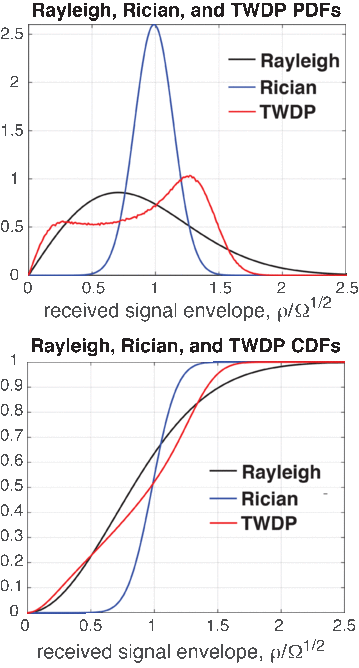TWDP fading
Two-Wave with Diffuse Power or TWDP fading is a stochastic model for radio propagation fading. This type of fading is caused by the constructive-destructive interference of two strong radio waves and numerous smaller, diffuse waves. TWDP fading is a generalized form of physics-based wave fading distributions, which include Rayleigh fading and Rician fading as special cases.
History
For signal analysis, mathematicians and scientists had long sought envelope statistics for the problem of two sinusoids in the presence of Gaussian noise.[1][2] The application of this scenario for radio wave propagation, including the name two-wave with diffuse power (TWDP) fading and its popular KΔ parameterization, was first presented by Durgin, Rappaport, and de Wolf.[3] Frolik was the first to measure TWDP fading (in a plane fuselage), coining the term Hyper-Rayleigh to denote this and other fading scenarios that result in worse-than-Rayleigh received power outages for a radio link.[4] Subsequently, other researchers have developed alternate, improved expressions for the TWDP distribution and its statistics.[5][6]
Channel Characterization
TWDP fading arises in a radio channel characterized by two constant-amplitude waves and numerous, smaller radio waves that are randomly phased with respect to one another. A TWDP-distributed envelope R follows from the following combination of elementary random variables:
where and are independent uniform random variables over the interval [0,1); and are independent, zero-mean Gaussian random variables with standard deviation . The two constant amplitude components are referred to as the specular components of the fading model. The term represents the sum of numerous amplitudes and phases of smaller waves, which by the law of large numbers follows a complex Gaussian distribution.
TWDP fading PDF is characterized by three parameters: average power Ω, ratio of specular-to-diffuse power K, and disparity between specular components Δ. These three parameters are related to the amplitudes of the individual waves by
The K-factor may vary from 0 to . A value of corresponds to Rayleigh fading. A value of corresponds to the type of two-wave envelope fading experienced on a transmission line with reflections. The parameter varies from 0 to 1, with corresponding to Rician fading and corresponding to specular components of equal amplitude, .
Unlike its special cases of Rayleigh and Rician fading, there is no simple, closed-form solution for the probability density function (PDF) of received envelope for TWDP fading. Instead, the exact PDF is the result of the following definite integral:[7]
Numerous techniques have been proposed to approximate the TWDP PDF in closed form or evaluate its statistics directly.[3][5][6] The most commonly used approximate PDF for TWDP is
where
Implications for Wireless Communications
The formulation of TWDP fading upends conventional RF design by demonstrating a common physical scenario in which deep fades in received power occur more often than Rayleigh fading—often considered the "worst case design" scenario in fading wireless links by engineers and scientists. Thus, common performance metrics in mobile communications such as bit error rate,[8] outage probability,[9] diversity gains,[10] etc. can be significantly degraded by TWDP fading. Both measurements and theoretical predictions have shown that TWDP fading becomes more common as mobile radio links increase in both frequency and density.
References
- ↑ W.R. Bennett (April 1948). "Distribution of the sum of randomly phased components". Quarterly Journal of Applied Mathematics. 5.
- ↑ R. Esposito and L.R. Wilson (March 1973). "Statistical properties of two sine waves in Gaussian noise". IEEE Transactions on Information Theory. 19.
- 1 2 G.D. Durgin, T.S. Rappaport, D.A. de Wolf (2002). "New analytical models and probability density functions for fading in wireless communications". IEEE Transactions on Communications. 50 (6).
- ↑ Frolik, Jeff (April 2007). "A Case for Considering Hyper-Rayleigh Fading Channels". IEEE Transactions on Wireless Communications. 6 (4).
- 1 2 S.A. Saberali and N.C. Beaulieu (September 2013). "New Expressions for TWDP Fading Statistics". IEEE Wireless Communications Letters.
- 1 2 M. Rao, F.J. Lopez-Martinez, M.S. Alouini, A. Goldsmith (January 2015). "MGF Approach to the Analysis of Generalized Two-Ray Fading Models". IEEE Transactions in Wireless Communications. 14 (5).
- ↑ Durgin, Gregory (2003). Space-Time Wireless Channels. Upper Saddle River, NJ: Pearson.
- ↑ S.H. Oh and K.H. Li (July 2005). "BER performance of BPSK receivers over two-wave with diffuse power fading channels". IEEE Transactions on Wireless Communications. 4 (4).
- ↑ Y. Lu, X. Wang, J. Lu (May 2011). "Outage Probability of Cooperative Relay Systems in Two-Wave with Diffuse Power Fading Environments". Vehicular Technology Conference (VTC Spring), 2011 IEEE 73rd.
- ↑ W.S. Lee and S.H. Oh (December 2007). "Performance of dual switch-and-stay diversity NCFSK systems over two-wave with diffuse power fading channels". Information, Communications & Signal Processing, 2007 6th International Conference on.
